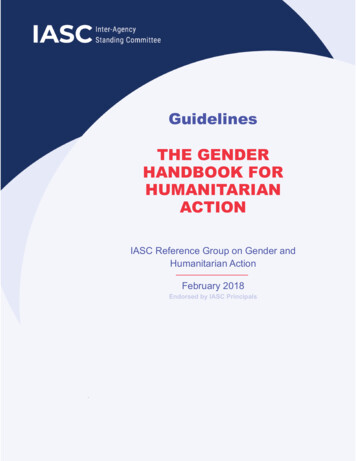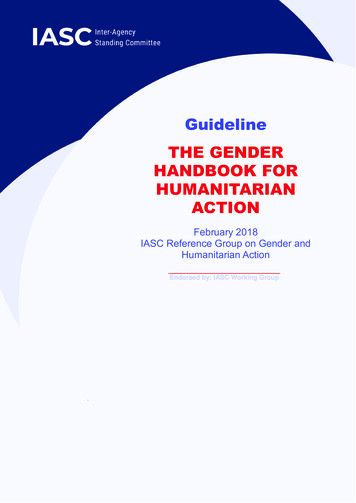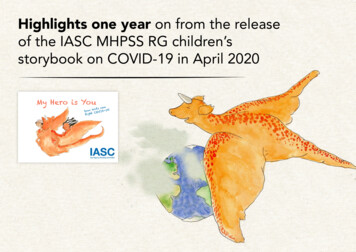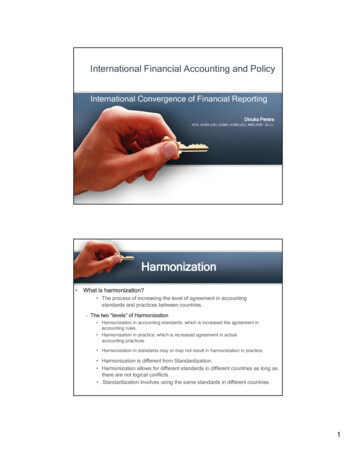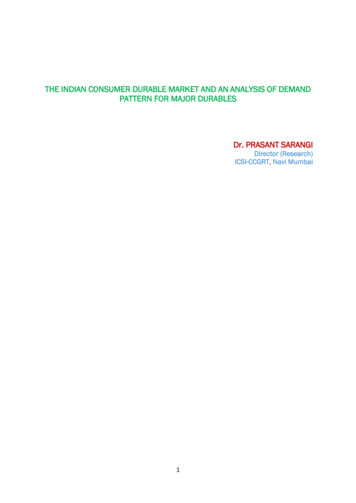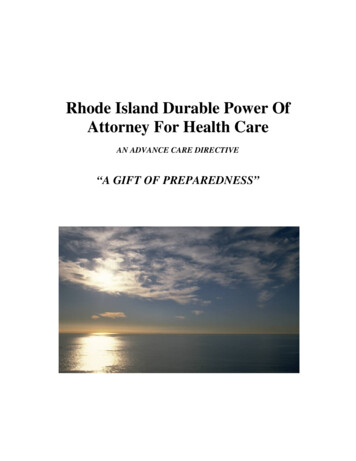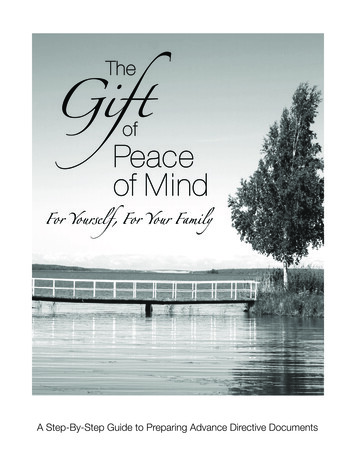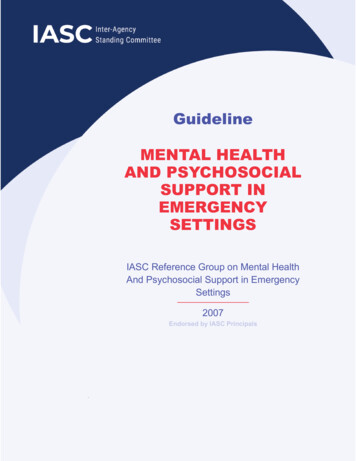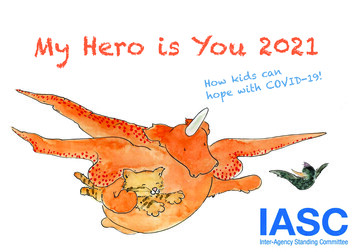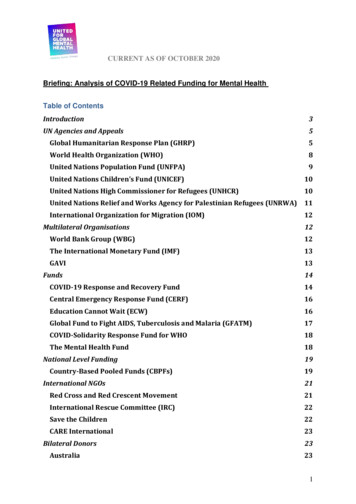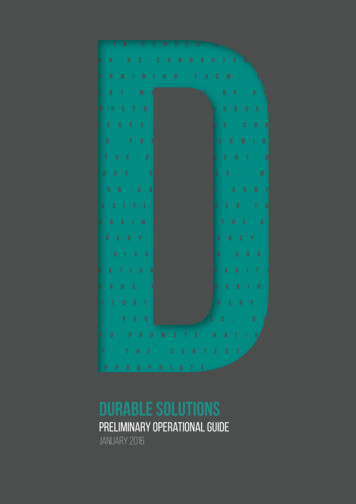
Transcription
Durable SolutionsPreliminary Operational GuideJanuary 2016
Joint Strategies to support DurableSolutions for Internally Displaced Persons(IDPs) and Refugees Returning to theirCountry of OriginA PRELIMINARY OPERATIONAL GUIDE TO THE UNITEDNATIONS SECRETARY-GENERAL’S DECISION ONDURABLE SOLUTIONS TO DISPLACEMENTUNDP and UNHCR, Global Cluster for Early Recovery, (Technical WorkingGroup on Durable Solutions) with the Global Protection ClusterWith the generous contribution of ECHOAnd acknowledgements to Erin Mooney and Anne Davies for their leadingroles in drafting this Guide.
TABLE OF CONTENTS08 Introduction09 QUICK Guide15 FULL GUIDE35 Supplementary guidance and resources38 ANNEX 140 ANNEX 2
ACRONYMSAAPADBAccountability to Affected PopulationsAsia Development BankABfDAfrican Bank for DevelopmentCCACommon Country AssessmentCEBCouncil of Europe Development BankCSOCivil Society OrganizationDDRDisarmament, Demobilization, and ReintegrationEBRDEuropean Bank for Reconstruction and DevelopmentERAEarly Recovery AdvisorGCERGlobal Cluster FOR Early Recovery (formerly CWGER)GPCGlobal Protection ClusterHCHumanitarian CoordinatorHCTHumanitarian Country TeamIASCInter-Agency Standing CommitteeICCM / ICCG Inter-Cluster Coordination Mechanism [or Group]IDMCInternal Displacement Monitoring CentreIDPsInternally Displaced PersonsILOInternational Labour OrganizationINGOInternational Non-Governmental OrganizationIOMInternational Organization for MigrationIRFImmediate Response FacilityISFIntegrated Strategic Framework
IDPsJoint IDP Profiling ServiceNational Development PlanNon-Governmental OrganizationOffice for the Coordination of Humanitarian AffairsOffice of the High Commissioner for Human RightsPeacebuilding FundPeacebuilding Support OfficePoverty Reduction Strategy PaperProtection CapacityResident Coordinator, United NationsResident Coordinator’s OfficeSustainable Development GoalsSecretary-GeneralUnited Nations Special Rapporteur on the Human Rights ofInternally Displaced PersonsSRP/HRPStrategic Response Plan/ Humanitarian Response PlanSRSGSpecial Representative of the United Nations Secretary-GeneralToRTerms of ReferenceTWG-DSTechnical Working Group on Durable SolutionsUNDAFUnited Nations Development Action FrameworkUNDGUnited Nations Development GroupUN-DOCOUnited Nations Development Operations Coordination OfficeUNEPUnited Nations Environment ProgramMEUNESCOUnited Nations Educational, Scientific and Cultural OrganizationUN-Habitat United Nations Human Settlements ProgrammeUNCTUnited Nations Country TeamUNHCRUnited Nations High Commissioner for RefugeesUNICEFUnited Nations Children’s FundWFPWorld Food Programme
introductiondINTRODUCTION to thesecretary-general’s decisionIn October 2011 the UN Secretary-General adopted a Decision on Durable Solutions and anaccompanying Preliminary Framework on Ending Displacement in the Aftermath of Conflict(hereinafter: SG Decision – Annex 1). This affirms the primary role of the State in facilitatingdurable solutions for displacement. On the international side, it designates to Resident/Humanitarian Coordinators (RC/HCs) the responsibility of leading the process of durablesolutions strategy development for IDPs and returning refugees, determining the mostappropriate approach based on consultation with national authorities and partners.SECURING DURABLE SOLUTIONS FOR INTERNALLYDISPLACED PERSONS AND REFUGEES IS A JOINTRESPONSIBILITY AND ONE THAT NEEDS TO BEUNDERTAKEN PROGRESSIVELY. WE HAVE LEARNEDMANY LESSONS IN THE FIELD. NOW WE MUST USEWHAT WE HAVE LEARNED TO BRING TOGETHER MOREACTORS TO ACHIEVE COMMON COMMITMENTS.– UN Secretary-General Ban Ki-moon addressing the annual meeting inGeneva of UNHCR’s Executive Committee (ExCom), 1 October 2014.KEY ELEMENTS OF THE SG DECISION: Resolving displacement is a collective responsibility requiring a joint and coherentstrategy; RC/HCs lead a consultative process to determine both the form and content of durablesolutions strategies; Technical support is available from UNDP and UNHCR, the Global Cluster for EarlyRecovery and Global Protection Cluster, and other structures with specific expertise, asoutlined in the Framework included with the SG Decision. The UN Peacebuilding Fund will consider requests from eligible countries for supportingimplementation of strategies for durable solutions to displacement.introduction DURABLE SOLUtions on displacement9 9
quick guideSCOPEQUICKGUIDEJoint Strategies tosupport DurableSolutions for InternallyDisplaced Persons(IDPs) and RefugeesReturning to theirCountry of OriginThis Guide has been developed in accordance with the SGDecision: to develop guidance for field-based practitionerson how to develop a strategy for supporting durablesolutions for Internally Displaced Persons (IDPs) andrefugees returning to their country of origin. The Guideis thus limited to situations where there are internallydisplaced persons and where refugees have returned totheir countries of origin or habitual residence, if not to theirregions of origin.While the SG Decision explicitly refers to “endingdisplacement in the aftermath of conflict” it is relevantto other displacement situations. Disasters, generalizedviolence, human rights violations and developmentrelated displacement similarly require a rights-basedapproach and a collective, coherent and coordinatedresponse. In reality, displacement can arise in contextscharacterized by a complex mix of conflict, disasters andenvironmental degradation.DISSEMINATION OF THE SG DECISION ANDFRAMEWORKABOUT THIS GUIDEThe Quick Guide to operationalizing the United NationsSecretary-General’s Decision on Durable Solutions toDisplacement provides a summary version of key elementscontained in the Full Guide. Intended primarily for Resident/Humanitarian Coordinators (RC/HCs) and Heads of Agency inCountry Offices, it recalls the responsibility, set out in the SGDecision, of RC/HCs to lead the process of durable solutionsstrategy development among international actors andsummarizes key points, including the suggested nine steps,for organizing the strategy development process. Details onthe 9 steps can be found in the Full Guide.A 2012 joint memo from the UNDP Administrator, Chairof the UN Development Group, and the UN EmergencyRelief Coordinator, called upon RC/HCs to make use of andfurther disseminate these documents, emphasizing theirsignificant implications for their work1 (Annex 2). Otherbodies that have referenced the SG Decision are: UN General Assembly2 UN Special Rapporteur on the Human Rights ofInternally Displaced Persons3 Organization for Security and Cooperation in Europe(OSCE)41 UnitedNations, Inter-Office Memorandum to Resident and Humanitarian Coordinators from Helen Clark, Chair, UN DevelopmentGroup and Valerie Amos, Emergency Relief Coordinator, 3 April 2012.2UN General Assembly, Resolution 68/180, 18 December 2013, UN Doc. A/RES/68/180.3 See, for example, Statement by Chaloka Beyani, Special Rapporteur on the Human Rights of Internally Displaced Persons, 68thsession of the General Assembly, 24 October 2013.4 ProtectionChecklist: Addressing Displacement and Protection of Displaced Populations and Affected Communities along theConflict Cycle: A Collaborative Approach (OSCE and UNHCR, 2014).10DURABLE SOLUtions on displacement quick guide
quick guideHow to develop a jointstrategy for durablesolutionsWhile there is no single blueprint for developing a multipartner durable solutions strategy and each displacementcontext is unique, it is possible to identify certain key steps.0102030405INITIATE THEPROCESSDESIGNATE DERSTANDINGOF CORE CONCEPTS,PRINCIPLES, ANDCRITERIACOLLECT ANDANALYSE DATA06070809AGREE ONOBJECTIVES ANDRESPONSIBILITIESDRAFT THE STRATEGYDOCUMENTVALIDATE ANDADOPT THESTRATEGYIMPLEMENT THESTRATEGY ANDMONITOR PROGRESSTOWARDS DURABLESOLUTIONSCONSULTquick guide DURABLE SOLUtions on displacement11 11
quick guide0102030405INITIATE THEPROCESSDESIGNATE DERSTANDINGOF CORE CONCEPTS,PRINCIPLES, ANDCRITERIACOLLECT ANDANALYSE DATATHE 9-STEP MODELThis 9-step model is intended as indicative, providinga general overview and a sense of the logical flow ofrecommended steps in developing a joint durable solutionsstrategy. In practice, the process will not necessarily belinear. These steps often will not occur sequentially, inthe order indicated. Some later steps may have to beundertaken while waiting for an earlier step to be completed(eg. data collection). Flexibility is key; in particular, toanticipate and plan around possible constraints as well as toseize unexpected opportunities that arise along the way.Moreover, each step may not require equal amounts oftime: gathering and analysing data may need more time thandeciding to initiate a process of developing a strategy (Step1). Implementation (Step 9) almost certainly will be a stagelasting several years. For details on each of the 9 steps,please refer to the Full Guide.KEY ACTORSNational authorities have the primary responsibility fordeveloping a durable solutions strategy5. Where possible,international actors must take the lead from and adapt tonational structures and systems in durable solutions strategydevelopment and implementation.12supporting the RC/HC’s strategic planning function needsto be fully involved in every stage of the strategy, fromconception to evaluation.Under the leadership of the RC/HC or her/his designatedofficial, all parts of a UNDP team in the country must beaware of their support roles. The early role of UNDP andother development actors is crucial to the development andimplementation of a durable solutions strategy.The SG Decision notes that UNHCR, as an agency andthrough the GPC, has a key role in providing technicalassistance to the development of durable solutionsstrategies. The SG Framework underscores UNHCR’sstatutory mandate to lead international coordination of theresponse to refugee flight, including both protection andthe search for solutions. It also has responsibility for leadinginternational coordination of protection for IDPs under thecluster system, including ensuring that IDPs can access asafe, voluntary, and dignified solution to displacement.Durable solutions rely on the combination of a proactiveUNHCR role (both in the humanitarian framework and inthe evolution towards development) and a proactive UNDProle in ensuring that the medium and longer-term solutionsbecome an integral part of the UN development framework(UNDAF). All humanitarian and development actors areexpected to seek ways to collaborate on the design andimplementation of solutions strategies.The RC/HC leads discussions on the overall strategy withgovernment, national and international actors. A designatedsenior official from the RC/HC’s office, or from UNHCR, UNDPor OCHA, may perform this task on her/his behalf.The UNCT and HCT should systematically discuss durablesolutions at the early planning stages – important for allpopulation groups including host communities.The programme committee or other unit entrusted withIn cases where the Cluster system is activated, OCHAand all cluster coordinators will be crucial partners forDURABLE SOLUtions on displacement quick guide
quick guide06070809AGREE ONOBJECTIVES ANDRESPONSIBILITIESDRAFT THESTRATEGYDOCUMENTVALIDATE ANDADOPT THESTRATEGYIMPLEMENT THE STRATEGYAND MONITOR PROGRESSTOWARDS DURABLESOLUTIONSdata-sharing and analyses, including on protection, rootcauses of displacement and conflict triggers, as well as onsectoral needs that arise in the course of displacement.Such data will help government, national and internationaldevelopment actors prioritise these areas for durablesolutions. OCHA can share information and analysis even incases where the cluster system is no longer active or has notbeen activated, i.e. in cases where sectors or working groupsare active instead of Clusters. Other humanitarian actors- national and international NGOs, civil society, ICRC, IFRC need to be aware of existing programmes and systems todesign interventions that complement national structuresand facilitate the timely draw-down of emergency responses.The private sector and the media often have support rolesto play, especially resource mobilization; their participationneeds to be determined or managed according to localstakeholder analysis.ACHIEVING DURABLE SOLUTIONSTo assist in the achievement of durable solutions, eightcriteria or benchmarks for durable solutions todisplacement are set out in the IASC Framework on DurableSolutions for Internally Displaced Persons, cross-referencedin the SG Decision’s Framework, and complementary to it: Long-term safety, security and freedom of Voluntary reunification with family membersseparated during displacement; Participation in public affairs, at all levels, on an equalbasis with the resident population; Effective remedies for displacement-related rightsviolations, including access to justice, reparations, andinformation on root causes.These also constitute a checklist for assessing to whatextent durable solutions are achieved for IDPs in anygiven context. On this basis, it is then possible to determinewhat areas of interventions require more attention and/orprioritization.A NOTE ON RESOURCE MOBILIZATIONAchieving durable solutions to displacement over a multiyear period will inevitably require significant resources.National responsibility requires that governments devotenational resources to create the enabling conditions fordurable solutions to displacement6. National authoritieswill need to make budgetary allocations to support durablesolutions in areas of return, settlement or local integration.Durable solutions should also be integrated into nationalpeacebuilding and conflict resolution, anti-poverty and othertransitional and development plans.movement; Adequate standard of living, including at a minimumaccess to adequate food, water, housing, health careand basic education; Access to employment and livelihood opportunities; Access to mechanisms to restore housing, land andproperty or provide compensation; Access to and replacement of personal and otherdocumentation;5SeeAddressing Internal Displacement: A Framework forNational Responsibility, The Brookings Institution-Universityof Bern, Project on Internal Displacement, April 2005. Theframework provides clear and measurable benchmarks tohelp governments address internal displacement in theircountries.6AddressingInternal Displacement: A Framework for NationalResponsibility (2005). See in particular Benchmarks 10 and 11.quick guide DURABLE SOLUtions on displacement13 13
quick guideIn many cases, needs in every sector are of such amagnitude as to lead governments to request assistancefrom the international community. The SG Framework callsfor a “coordinated strategy for resource mobilization”. Sucha plan should seek to mobilize resources through a rangeof humanitarian, development, international financinginstruments and peacebuilding funding mechanisms, bothat the national and international level. Any fundraisingactivities need to be well coordinated with other governmentefforts, as well as with those related to international planningprocesses. They need to be well supported by others toensure the inclusion of persons of concern, sequenced andviable planning and the elements necessary for sustainablesolutions. Elements of the strategy should be integrated intoexisting planning and resource mobilization processes. Keynational and international resource mobilizing instrumentsinclude, but are not limited to: Strategic/Humanitarian Response Plans, includingaccess to CERF, ERF and CHF7 instruments National Development Plans8 United Nations Development Assistance Framework(UNDAF), Country Common Assessment (CCA) Integrated Strategic Frameworks (ISFs) or otherIt may be useful to convene with the government adonor conference to promote resource mobilization forimplementation of the durable solutions strategy. However,partners should be discouraged from over-ambitiousexpectations.LEGAL INSTRUMENTSWhile the SG Decision does not refer to specific legalinstruments to advocate for durable solutions, point 7 ofthe accompanying Preliminary Framework emphasizesthe importance of a rights-based approach. Relevant legalstandards include in particular: international human rightsand international refugee law, international humanitarian law(if the situation is one of armed conflict), the African UnionConvention for the Protection and Assistance of InternallyDisplaced Persons in Africa and the Guiding Principles onInternal Displacement.PROGRESS REPORTSInternational and interagency networks, including the GCERand GPC, will welcome receiving periodic progress reports inthe development and implementation of durable solutionsstrategies. Such reporting at the global level facilitates thesharing of field practice and may also be useful for advocacypurposes and resource mobilization efforts.mechanisms produced under the United Nations Policyon Integrated Assessment and Planning (2012) UN Peacebuilding Fund (PBF) International financial institutions Trust Funds Concessional financingEngagement with Solutions Alliance members throughoutGlobal networks and organisations committed to supportingmulti-partner Durable Solutions efforts, including the GCERand the GPC (erhelpdesk@undp.org and GPC@unhcr.org),the Solutions Alliance and the PBSO can provide technical,advocacy and material support at different phases.To submit documents or receive additional support, contact:erhelpdesk@undp.org and GPC@unhcr.org.the conception and drafting processes may help identifyallies at global and local levels.7Central Emergency Response Fund, Emergency Response Fund, Common Humanitarian Fund8The UN Development Group recognizes that “it is essential that displaced persons are included in national development plans andrelated resource mobilization strategies.” The UNDG has issued guidance on how to include durable solutions for displaced personsinto UNCT analysis and strategic development framework, specifically in the UN Development Assistance Framework (UNDAF). Formore information see: www.undg.org14DURABLE SOLUtions on displacement quick guide
FULL GUIDE
full guideAGENDA 2030The people of the world have asked usto shine a light on a future of promiseand opportunity. Member States haveresponded with the 2030 Agenda forSustainable Development. The newagenda is a promise by leaders to allpeople everywhere. It is a universal,integrated and transformative visionfor a better world. It is an agendafor people, to end poverty in all itsforms. An agenda for the planet, ourcommon home. An agenda for sharedprosperity, peace and partnership.It conveys the urgency of climateaction. It is rooted in gender equalityand respect for the rights of all. Aboveall, it pledges to leave no one behind.Secretary General’s remarks at theadoption of Agenda 2030, September2015WHY DURABLE SOLUTIONS?Displacement can be devastating, whether short-term orprotracted, internal or external. Consequences include lossof home, land and belongings; disruption of livelihoodsor education; separation from community and familymembers; loss of personal documentation and heightenedexposure to protection risks, including the psychologicaleffects of disenfranchisement, loss and trauma. The specificvulnerabilities created by displacement often only intensifywith time, while resilience, the ability of communities torebuild their lives even while displaced, can weaken if it is notnourished.9Displacement can also have serious economic, politicaland security implications: the presence of large numbersof displaced persons in host communities can strainpublic infrastructure and social services and potentiallyjeopardize development gains. On the other hand, displacedcommunities can have positive impacts where populationsare free to work and where there is sufficient capacity toabsorb and to integrate them.Durable solutions to displacement are essential. IDPsand refugees have the right, enshrined in internationallaw, to a solution, whether through voluntary return andreintegration, local integration or relocation. Solutions todisplacement are indispensable for national, regional, andinternational peace and security and for creating the stableand secure conditions that are essential for achievingsustainable development goals for everyone.In October 2011, pursuant to a recommendation by hisPolicy Committee, the UN Secretary-General adopteda Decision on Durable Solutions (Annex 1) and anaccompanying Preliminary Framework on EndingDisplacement in the Aftermath of Conflict (hereinafter:SG Decision9) which affirms the primary role of the State infacilitating solutions for displacement.KEY ELEMENTS OF THE SG DECISION: Resolving displacement is a collective responsibilityrequiring a joint and coherent strategy; RC/HCs lead a consultative process to determine boththe form and content of durable solutions strategies; Technical support is available from UNDP and UNHCR,the Global Cluster for Early Recovery and GlobalProtection Cluster and other structures with specificexpertise, as outlined in the Framework included withthe SG Decision. The UN Peacebuilding Fund will consider requests fromeligible countries for supporting implementation ofstrategies for durable solutions to displacement.Globally, the SG Decision assigns responsibility to the GCERand the GPC, including support and guidance, and theDecisions of the Secretary-General, 4 October meeting of the Policy Committee; Decision No.2011/20 - Durable Solutions: Followup to the Secretary-General’s 2009 report on peacebuilding. See Annex 1.16DURABLE SOLUtions on displacement full guide
full guidemaintenance of a repository of strategies and lessonslearned. Since the launch of the pilot, it has become clearthat this support can come from a number of differententities, not least the agencies and NGOs involved, theSolutions Alliance, strategic planning teams in RC/HCs’ officesand of course national governments. The SG Decision alsorequested the CWGER (now GCER10) and the GPC to ensurethat Early Recovery Advisors deployed to support in-countrycrisis response have the necessary expertise on durablesolutions, and to develop guidance for the development ofdurable solutions strategies (this Guide). Such support can– and has - come from a number of sources, including fromstrategic planning experts funded jointly by UNHCR andUNDP.OPERATIONAL EXPERIENCESHOWS THAT SUSTAINABLYENDING DISPLACEMENT ISONE KEY TO AVOID LONGLASTING IMPACTS OFDISASTERS ON THE WELLBEING OF BOTH THE PEOPLEDISPLACED AND THEIR HOSTCOMMUNITIES.Louis Hoffman,Head, Transition & Recovery, IOMSCOPEThe SG Decision targets in particular solutions for IDPs andrefugees returning to their country of origin. The scopeof this Guide is thus limited to situations where there areinternally displaced persons and where refugees havereturned to their countries of origin or habitual residence, ifnot to their regions of origin. It is not relevant for use whererefugees remain in countries of asylum, benefiting from theinternational protection system.While the SG Decision explicitly refers to “endingdisplacement in the aftermath of conflict” it is relevantto other displacement situations. Disasters, protractedsituations, generalized violence, human rights violationsand development-related displacement similarly requirea rights-based approach and a collective, coherent andcoordinated response. In reality, displacement can arise incontexts characterized by a complex mix of conflict, disastersand environmental degradation.DISSEMINATION OF THE SG DECISION ANDFRAMEWORKA 2012 joint memo from the UNDP Administrator andChair of the UN Development Group and the UNEmergency Relief Coordinator called upon RC/HCs tomake use of and further disseminate these documents,emphasizing their significant implications for their work11(Annex 2). Other bodies that have referenced the SGDecision are: UN General Assembly12 UN Special Rapporteur on the Human Rights ofInternally Displaced Persons13 Organization for Security and Cooperation in Europe(OSCE)1410 Anyreference in the SG Decision to the CWGER is rephrased as GCER throughout this document.11 UnitedNations, Inter-Office Memorandum to Resident and Humanitarian Coordinators from Helen Clark, Chair, UN DevelopmentGroup and Valerie Amos, Emergency Relief Coordinator, 3 April 2012.12 UNGeneral Assembly, Resolution 68/180, 18 December 2013, UN Doc.A/RES/68/180.13 See,for example, Statement by Chaloka Beyani, Special Rapporteur on the Human Rights of Internally Displaced Persons, 68thsession of the General Assembly, 24 October 2013.14 ProtectionChecklist: Addressing Displacement and Protection of Displaced Populations and Affected Communities along the Conflict Cycle:A Collaborative Approach (OSCE and UNHCR, 2014). Session of the General Assembly, 24 October 2013.full guide DURABLE SOLUtions on displacement17 17
full guideTHE ROLES OF DIFFERENT ACTORSNational authorities have the primary responsibility fordeveloping a durable solutions strategy. Where possible,international actors must take the lead from and adapt tonational structures and systems in durable solutions strategydevelopment and implementation.The RC/HC leads discussions on the overall strategy5 withgovernment, national and international actors. A designatedsenior official from his/her office, or from UNHCR, UNDP orOCHA, may perform this task on her/his behalf.The programme committee or other unit entrusted withsupporting the RC/HC’s strategic planning function needsto be fully involved in every stage of the strategy, fromconception to evaluation.Under the leadership of the RC/HC, all parts of a UNDP teamin the country must be aware of their support roles. UNDP’sspecialized work in early recovery, livelihoods, sustainabledevelopment, good governance, rule of law, social cohesion,capacity-strengthening of national and local authorities as wellas local NGOs, is relevant to all four essential areas of durablesolutions according to the SG Framework:a. Social and economic recovery,b. Protection, security and the rule of lawc. Governance, andd. Social Cohesion.In the aftermath of crises, as humanitarian actorsprogressively phase out, the roles of UNDP, otherdevelopment actors as well as peace and security actorsincrease in importance in addressing root causes and infurthering solutions.The SG Decision notes that UNHCR, as an agency andthrough the GPC, has a key role in providing technicalassistance, in the development of durable solutionsstrategies. The SG Framework underscores UNHCR’sstatutory mandate to lead international coordination of theresponse to refugee flight, including both protection andthe search for solutions. It also has responsibility for leadinginternational coordination of protection for IDPs under thecluster system, including ensuring that IDPs can access asafe, voluntary, and dignified solution to displacement.18DURABLE SOLUtions on displacement full guideDurable solutions rely on the combination of a proactiveUNHCR role (both in the humanitarian framework and inthe evolution towards development) and a proactive UNDProle in ensuring that the medium and longer-term solutionsbecome an integral part of the UN development framework(UNDAF).OCHA and all Cluster coordinators need to be prepared toshare analysis on root causes of displacement and conflicttriggers, as well as on the effects of displacement on eachsector to help governments, national and internationaldevelopment actors prioritise these areas.THE VERY OBJECTIVE OFEFFORTS TO PROTECT AND ASSISTREFUGEES AND INTERNALLYDISPLACED PERSONS IS TO FINDA SOLUTION TO THEIR PLIGHT.THIS MEANS, FOR EXAMPLE,THAT UNHCR IS DUTY BOUNDTO REMAIN ENGAGED WELLBEYOND THE EMERGENCYPHASE. OUR UNDERSTANDINGOF SOLUTIONS HAS EVOLVEDAND NOW ACKNOWLEDGESTHE IMPORTANCE OF SELFRELIANCE AND COMMUNITYBASED ACTIVITIES FROM THEONSET OF DISPLACEMENT.WHERE THERE IS NO IMMEDIATESOLUTION AVAILABLE, WEMUST COLLECTIVELY DOEVERYTHING POSSIBLE TOREDUCE DEPENDENCY SO THATPOPULATIONS OF CONCERNCAN LEAD PRODUCTIVE ANDDIGNIFIED LIVES.Volker Turk, Director of InternationalProtection, UNHCR, 2013
full guideOther humanitarian actors need to be aware of existingprogrammes and systems in order to design interventionsthat complement national structures and facilitate the timelydraw-down of emergency responses.Similarly, other development actors are encouraged to joinUNDP in: adapting existing programmes and priorities to addressthe root causes of flight and the needs of returned andrelocating IDPs and returned refugees; and including, in advocacy with governments, the keyelements of analysis identified during the first part ofthe response, including the voices of displaced and hostcommunities themselves. including returned refugees and IDPs in regularprogramming;How to develop a joint strategyfor durable solutions0102030405INITIATE THEPROCESSDESIGNATE DERSTANDINGOF CORE CONCEPTS,PRINCIPLES, ANDCRITERIACOLLECT ANDANALYSE DATA06070809AGREE ONOBJECTIVES ANDRESPONSIBILITIESDRAFT THE STRATEGYDOCUMENTVALIDATE ANDADOPT THESTRATEGYIMPLEMENT THESTRATEGY ANDMONITOR PROGRESSTOWARDS DURABLESOLUTIONSCONSULTfull guide DURABLE SOLUtions on displacement19 19
full guide0102030405INITIATE THEPROCESSDESIGNATE DERSTANDINGOF CORE CONCEPTS,PRINCIPLES, ANDCRITERIACOLLECT ANDANALYSE DATATHE 9-STEP MODELWhile each displacement context is unique and there istherefore no single blueprint for developing a joint durablesolutions strategy, it is possible to identify certain key stepsrelevant to all situations.This 9-step model is intended as indicative, providinga general overview and a sense o
Durable solutions rely on the combination of a proactive UNHCR role (both in the humanitarian framework and in the evolution towards development) and a proactive UNDP role in ensuring that the medium and longer-term solutions become an integral part of the UN development framework (UNDAF). All humanitarian and development actors are
